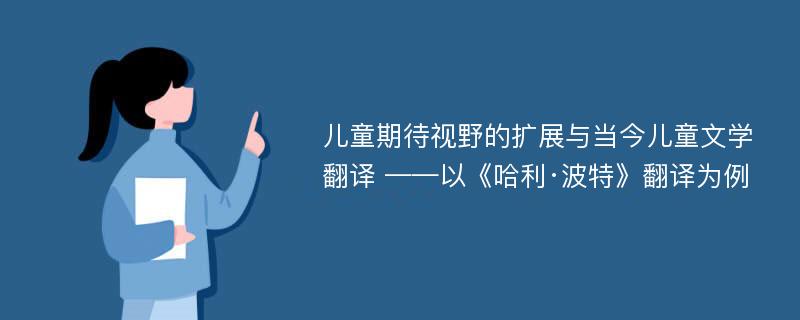
论文摘要
当今,翻译研究受到越来越多的关注;但令人遗憾的是,在国内,翻译研究者对儿童文学翻译的关注远远少于成人文学翻译。如果我们回顾一下中国儿童文学的发展历程,不难发现到这样的事实:自清代以来,我国儿童文学的发展史是和优秀外国儿童文学的译介史紧紧相连的,这足以证明外国儿童文学译介的重要地位。对儿童文学翻译的研究在国际上已经起步,但在中国,这一领域的深入研究还暂付阙如,这使得我国儿童文学翻译的研究迫在眉睫。二十世纪六、七十年代在德国兴起了一种文艺批评理论——接受理论,为儿童文学翻译的研究提供了良好的理论基础。与传统理论不同,接受理论强调以读者为中心。接受理论认为,作者—作品—读者所形成的总体关系中,读者绝不是可有可无的因素。离开了读者的审美接受,作品就没有了现实意义。此外,接受理论的一条重要原则就是“视野融合”,只有读者的期待视野与文学文本相融合,才能谈得上接受和理解;而读者的期待视野并不是一成不变的,它因时代的变化而不断发展。这就意味着,在译介的过程中,译者应以读者为中心,既要考虑读者的期待视野和接受能力,还要关注读者期待视野的变化和发展,这一点对于儿童文学的翻译尤为重要。本论文主体分为四个部分。第一章从儿童文学翻译的定义和特点、地位、及国内外研究现状三个方面对儿童文学翻译进行总结。第二章介绍了接受理论的主要思想,以及接受理论对儿童文学翻译的可行性及启示。为接下来的文本分析打下坚实的理论基础。第三章,作者认为,随着社会的进步、科技的发展、物质文化生活水平的提高和东西方文化的频繁交流,儿童的知识结构、认知能力、期待视野都有了很大的提高,这对当代儿童文学翻译和研究都是一个不容忽视的新特点。作者认为当今儿童文学的译介应该考虑当今儿童期待视野变化扩展这一现实因素,不论是在选材还是翻译策略上都应与时俱进,符合当今儿童的期待视野。第四章,借用接受理论的重要原则,以《哈利·波特》大陆版译本为例,分析儿童期待视野与儿童文学翻译之间的关系,探讨儿童期待视野的变化对当今儿童文学翻译的影响和启示。
论文目录
摘要AbstractIntroductionChapter 1 Children's Literature in Literary Translation1.1 Children's Literature1.1.1 Definition of Children's Literature1.1.2 Classification of Children's Literature and Its Features1.2 The Status of Children's Literature in Literary Translation1.3 Previous Translation Studies in Children's Literature1.3.1 Relevant Studies in China1.3.2 Relevant Studies in Other Countries1.4 Limitations of Previous Research on the Translation of Children's LiteratureChapter 2 Reception Theory:Applicable to the Translation ofChildren's Literature2.1 Reception Theory2.1.1 Historical Development of Reception Theory2.1.2 Some Important Concepts of Reception Theory2.1.2.1 The Role and Status of the Reader2.1.2.2 The Horizon of Expectation of the Reader2.2 Reception Theory in Translation of Children's Literature2.2.1 Feasibility of the Reception Theory2.2.2 Enlightenments to the Translation of Children's Literature2.2.2.1 Reader's Role and Status2.2.2.2 Children's Horizon of Expectation2.2.2.3 Readers'Reception and Response to TranslationChapter 3 Changes of Horizon of Children's Expectation and thePresent-age Translation of Children's Literature3.1 The Change of the Horizon of Children's Expectation3.1.1 Factors Leading to the Change3.1.1.1 Accumulation of Reading Experience3.1.1.2 External Factors3.1.2 Changes Made in Different Periods in China3.2 Translation of Children's Literature in the Present Age3.2.1 In Material Choice:Diversified,Exotic and Fashionable3.2.2 In Translation Strategies:Possibility of Foreignizing Translation3.2.2.1 The Horizon of Expectations and the Translation Strategies3.2.2.2 The Change of Horizon of Expectation and ForeignizationChapter 4 Translation of Harry Potter in China under the ReceptionTheory4.1 Introduction to the Translation of Harry Potter Series4.1.1 About the Author4.1.2 About the Main Translators4.1.3 About the Target Readers4.1.4 Previous Translation Studies on Harry Potter4.2 Material Choice4.2.1 The Horizon of Expectation of Harry Potter4.2.2 The Fusion of Horizons between Harry Potter and Children4.2.2.1 Catering to the Children's Fantastic Imaginations4.2.2.2 A Creative Text Conform to the Tastes of Children4.2.2.3 Unique and Lovely Child Image4.2.2.4 Abounds with Modern Elements4.3 Strategies Applied to the Translation of Harry Potter4.3.1 Position of the Target Readers in Translator's Mind4.3.2 Domestication and Foreignization in Light of Horizon of Expectation4.3.2.1 Domesticating Translation of Harry Potter4.3.2.1.1 The Advantages of Domestication4.3.2.1.2 The Defects of Domestication4.3.2.2 Foreignizing Translation of Harry Potter4.3.2.2.1 Advantages4.3.2.2.2 Defects4.3.2.3 The Change of Horizon of Expectation and the Characteristics of the Translated Version4.4 The Reader-Response of Harry Potter in ChinaConclusionNotesBibliographyAcknowledgements攻读学位期间主要的研究成果目录
相关论文文献
- [1].中国儿童文学师夷说[J]. 浙江师范大学学报(社会科学版) 2009(01)
标签:儿童文学译介论文; 接受理论论文; 期待视野论文; 哈利波特论文; 选材论文; 翻译策略论文;
儿童期待视野的扩展与当今儿童文学翻译 ——以《哈利·波特》翻译为例
下载Doc文档
